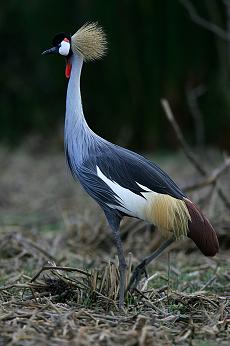Crane - Black Crowned
Scientific Name: Balearica pavonina
Sat, 12th July, 2025 - 8:04 am GMT
Sponsor Ads:

Alternative Name
Scientific Name: Balearica pavoninaBasic Info
The Black Crowned Crane, and other crowned cranes may be distinguished from other crane species by the presence of the "hallux," which are long hind toes. The hallux allow them to grip branches easily. This adaptation may explain why the Black and Grey Crowned Cranes roost in trees, while other species do not. There are two subspecies of Black Crowned Crane, the West African Crowned Crane (Balearica pavonina pavonina) and the Sudan Crowned Crane (Balearica pavonina ceciliae). The subspecies are quite similar in appearance, but they can be distinguished by the differences in their cheek coloration. The Sudan Crowned Crane has a red patch that extends much higher than that of the West African Crowned Crane.
Health
Breeding The Black Crowned Crane is often seen nesting in wetlands of its native Africa. They form large circular nests made primarily of grasses. After the females lay their eggs, they will incubate between 28 and 31 days. After hatching the birds will usually move out of the wetlands into drier regions. The average number of babies is between two and three. Babies fledge between 60 and 100 days.Habitat
Only found in AfricaBehavior
The Black Crowned Crane is cherished for its astonishing grace and beauty. This striking bird is native to Africa, where it is held in high esteem and is often considered a symbol of good fortune. It is even the national bird of Nigeria. The Black Crowned Crane is unusual among cranes because it is one of the few cranes that have the ability to roost in trees. The only other crane known to exhibit this behavior is the Grey Crowned Crane. The Black Crowned Crane makes its home in the grasslands of Africa, though during the breeding season they are also found in wetlands.Origin
AfricaHistory
The Black Crowned Crane is a non-migratory bird that is only found in Africa, primarily in the Sahel region, which is north of the tropical rainforests but south of the Sahara. Sadly, their populations have seriously declined in West Africa, though they still maintain a stable population in Ethiopia and the Sudan savannas. The main causes for the population decline of the Black Crowned Crane is habitat destruction and serious draught. They are also commonly hunted and sold. The West African Crowned Crane has much lower population densities than the Sudan Crowned Crane. Conservation efforts are being made and it is currently protected in many African countries.Common Foods
In the wild they feed on insects and seeds.Sponsor Ads:
Dinosaurs aren't extinct. They've just learned to hide in the trees.
Crane - Black Crowned
Coded by: BGID® | ALL RIGHTS RESERVED Copyright © 2000-2025
Disclaimer | Privacy | Report Errors / Contact | Credits








 President of the United States of America - Real Estate mogul, Pageant owner and now one of the most controversial men in political history.
President of the United States of America - Real Estate mogul, Pageant owner and now one of the most controversial men in political history.  Global warming has been in and out as the "latest" hot topic for many years. It is, according to modern scientists, the result of man-made industrial pollutants, clearing forested areas, agriculture, etc. But now they are thinking it started way before the Industrial Revolution...
Global warming has been in and out as the "latest" hot topic for many years. It is, according to modern scientists, the result of man-made industrial pollutants, clearing forested areas, agriculture, etc. But now they are thinking it started way before the Industrial Revolution...  Politician, US Vice President and President of the USA - Joseph Robinette Biden Jr.
Politician, US Vice President and President of the USA - Joseph Robinette Biden Jr.  versus
versus  Russia: 'The Evil Empire'? Are they all that bad or is it just the USA trying to portray Russia as bad because they are a world power with land bigger and a society very different from the USA ideal?
Russia: 'The Evil Empire'? Are they all that bad or is it just the USA trying to portray Russia as bad because they are a world power with land bigger and a society very different from the USA ideal? 
 Corona virus
Corona virus 
 Users with wide screen monitors can benefit from more content on every page.
Users with wide screen monitors can benefit from more content on every page.